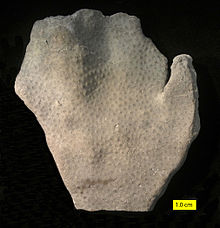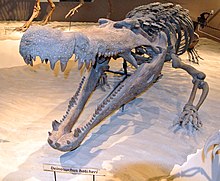Taxonomy of commonly fossilised invertebrates
This article has multiple issues. Please help improve it or discuss these issues on the talk page. (Learn how and when to remove these template messages)
|
- [ ! ]: Indicates clades that are important as fossils or very abundant in the fossil record.
- [ – ]: Indicates clades that contain a large proportion of extinct species.
- [ † ]: Indicates clades that are completely extinct.
The paleobiologic systematics that follow are not intended to be comprehensive, rather encompass invertebrates that (a) are popularly collected as fossils and/or (b) extinct. As a result, some groups of invertebrates are not listed.[1]
If an invertebrate animal is mentioned below using its common (vernacular) name, it is an extant (living) taxon, but if it is cited by its scientific genus, then it is typically an
Invertebrate clades that are important fossils (e.g.
Domain of Eukaryota/Eukarya

- most of the paleontologists, extinct or extant, are eukaryotic.
- includes: a wide variety of green plants; all animal-related kingdoms.
- does not include the .
Sub-domain of Opisthokonta
- most life forms documented, extinct or extant.
- excludes: many molds; all one-celled protists (protoctists); all algae; all green plants.
- excludes: many molds; all one-celled protists (
Kingdom of Metazoa - All Invertebrates and Vertebrates
- comprises most living and deceased species which have ever been recorded, extinct or extant.
- excludes all fungalopisthokonts.
- excludes all
Sub-kingdom of Parazoa
Parazoans; typically
Phylum Archeocyathida/Pleospongia [†]
Cone-shaped
Includes fossil
Archaeocyatha is sometimes classified as a
Phylum Nuda/Spongia

Quintessential
Porifera may eventually be broken up into separate phyla:
- Sub-phylum Calcispongiae (primitive calcareousporiferans such as yellow lemon sponge, sphinctozoans, pharetronids, Scypha, Leucetta, Gravestockia, Grantia, Astraeospongium, Clathrina, Lelapia, Rhaphidonema, and Girtyocoelia).
- Class Calcinea
- Class Calcaronea
- Class stromatoporoids/reef-building stromatoporates/button-shaped stromatoporids/disc-shaped spongliomorphids; e.g., Stromatopora, Aulacera, Stromatactis, Actinostroma, Discophyllum, Parallelopora and Amphipora)
- Class Heteractinida [†] (Paleozoic calcitic heteractinids such as Eiffelia)
- Sub-phylum siliceousporiferans):
- Class carnivorous sponge, bristle sponge, chaetids, lithistids, Astroclera, Ceractinomorpha, Clionoides, Hindia, Ventriculites, Laosoiadia, Clionolithes, Tetractinella, and Astylospongia)
- Class Venus flower basket, bird's nest sponge, cloud sponge, Hexactinella, Hydroceras, Dictyonina, Brachiospongia, Titusvillea, and Rhizopoterion)
- Class
Sub-kingdom of Eumetazoa
Eumetazoa contains most of the living and deceased species of recorded life, including most invertebrates (extinct and extant), as well as all vertebrate animals.
Super-phylum of Radiata
Radiates; non-bilaterian eumetazoans.
Phylum Cnidaria/Coelenterata

- Class Hydrozoa (hydra or hydroid group):
- Subclass stromatoporoids)
- Subclass Conulata[†] (four-sided, pyramidal conularians)
- Subclass
- Class Anthozoa (corals / polyps):
- Subclass soft corals and sea pens)
- Subclass extant corals)
- Order horn-shaped tetracorals such as Petoskey coral, Caninia and Heliophyllum)
- Order )
- Order living corals)
- Order
- Subclass
Super-phylum of Protostomia # 1
Phylum Bryozoa/Ectoprocta/Polyzoa

Bryozoans – half of all documented species of Bryozoa are fossils and extinct.[5]
- Class bryozoans):
- Order Cheilostomata[!] (living, rimmed-mouthed moss animals)
- Order Cyclostomatida (uncontracted, round-mouthed bryozoans including fossil Stomatopora)
- Order Cystoporata [†] (extinct, minor group of moss animals)
- Order Trepostomata[†] [!] (changed-mouthed bryozoans such as extinct Constellaria and Monticulipora)
- Order Cryptostomata [†] [!] (round hidden-mouthed bryozoans such as Archimedes, Fenestrellina and Rhombopora)
- Order Ctenostomata [†] (uncommon, comb-mouthed bryozoans)
- Order Phylactolaemata (living, fresh-water bryozoans)
- Order
Phylum Brachiopoda

- Subphylum Lingula) – but mostly extinct.
- Subphylum Crania) – but mostly extinct.
- Subphylum articulate brachiopodswith hinged valves; includes most extinct and living brachs).
- Class Rhynchonellata [!]
- Order Orthida [†] [!] (orthid brachs such as fossil Orthis)
- Order Pentamerida [†] (pentamerid brachs such as Conchidium)
- Order Rhynchonellida [!] (rhynchonellid brachs such as fossils Rhynchotrema and Rhynchonella)
- Order Spiriferida [†] [!] (spiriferid brachs)
- Suborder Spiriferinida [†] [!] (spiriferid brachs such as Spirifer and Eospirifer)
- Suborder Atrypida [†] [!] (atrypid brachs such as Atrypa)
- Order Terebratulida [!] (most living brachiopods; includes fossil Dielasma)
- Class Strophomenata [†] [!] (so-called petrified butterflies)
- Order Strophomenida [†] [!] (strophomenid brachs)
- Order Productida [†] [!] (spiny or productid brachs)
- Suborder Chonetidina [†] [!]
- Suborder Productidina [†] [!]
- Class Rhynchonellata [!]
Phylum Annelida
- Class marine annelids / polychaetes)
- Order Scolecodonta [!] (mostly scolecodonts)
- Order Scolecodonta [!] (mostly
Phylum Mollusca


Molluscs or
- Class extinct, except for "living fossil" Neopilina)
- Class Pelecypoda (bivalves / pelecypods) – half of all documented species of Bivalvia are fossils and extinct [6]
- Subclass )
- Class Gastropoda (gastropods / snail group)
- Subclass marine snails and conches)
- Subclass Opisthobranchia (sea slugs)
- Subclass Pulmonata (land snails)
- Subclass
- Class Cephalopoda(cephalopods) – 97 % of all documented species of Cephalopoda are now extinct
- Subclass Nautiloidea (mostly extinct, but includes "living fossil" Nautilus)
- Order long, straight-shelled nautiloids)
- Order
- Subclass ammonoids)
- Agoniatitic (agoniatites) [†]
- Goniatitic (sutures)
- Ceratitic (ceratites) [†]
- sutures)
- Subclass Coleoidea (includes the living squid, cuttlefish, and octopus)
- Order orthoconicbelemnoids)
- Order
- Subclass
Super-phylum of Protostomia # 2
Phylum Tardigrada
Panarthropodic
Phylum Onychophora
Panarthropodic
Phylum Arthropoda

Arthropods;
- Subphylum Crustacea(crustaceans)
- Class Ostracoda(ostracods)
- Class Malacostraca (true crabs, lobster and most shrimp)
- Class Branchiopoda (brine shrimp)
- Order Notostraca
- Class Cirripedia (barnacles)
- Class Arachnoidea
- Class
- Subphylum Trilobitomorpha [†] (extinct trilobitegroup)
- Class Trilobita[†] (the armored trilobites)
- Class
- Subphylum Hexapoda
- Class Insecta (insects, best preserved in amber)
- Class
- Subphylum Chelicerata
- Class )
- Class Xiphosura ("living fossil" horseshoe crabs)
- Subphylum Myriapoda
- Class Diplopoda
- Class Chilopoda
- Class
Super-phylum of Deuterostomia / Enterocoelomata
Second-mouthed
Phylum Echinodermata

Echinoderms – 72% of all documented species of Echinodermata are fossils and extinct.[7]
- Subphylum sessileechinoderms) – 91% of all documented species of Crinozoa are now extinct
- Class sea lilies) – See Crinozoa above
- Class
- Subphylum Blastozoa [†] (extinct blastoids)
- Class Diploporita
- Class Rhombifera
- Subphylum mobileechinoderms) – 89% of all documented species of Echinozoa are now extinct
- Class Echinoidea (echinoids or sea urchins) – See Echinozoa above
- Order Clypeasteroida
- Order Camarodonta
- Order
- Class
- Subphylum Asterozoa
- Class sea stars/ starfish)
- Class Ophiuroidea
- Class
Phylum Hemichordata

Hemichordates such as extant acorn worms – Less than half of the documented species of Hemichordata are fossils and extinct.
- Class Graptoloidea [†] (extinct graptolites)
- Order Dendroidea[†]
- Order Graptoloidea[†]
- Suborder Didymograptina [†]
- Suborder Diplograptina [†]
- Suborder Monograptina [†]
- Order
Phylum Chordata
Both invertebrate and vertebrate chordates; animals possessing a notochord.
Invertebrate subphyla
- Subphylum sea squirts)
- Subphylum Cephalochordata (invertebrate lancelets)
Subphylum Vertebrata

- Vertebrates such as .
See also
References
- ISBN 0-8137-3135-6).
- zoologistsMichael Hutchin, Dennis A. Thorney and Sean F. Craig (2003).
- ^ For correspondingly ancient ecosystems, see the Treatise on Ecology and Paleoecology, Volume 2: Paleoecology, edited for years by Harry S. Ladd (1957 / 1971), and published by both the Geological Society of America (Boulder, Colorado) and the Waverly Press (Washington, D.C.).
- ^ The rates of extinction for sponges and other phyla are derived from W. H. Easton, 1960, Invertebrate Paleontology (New York: Harper and Brothers) and various modern sources.
- ^ For bryozoans and brachiopods, the same footnote as above.
- ^ For bivalves and cephalopods (both mollusks), see the above notation.
- ^ For the echinoderms, see the above footnote regarding W. E. Easton, 1960, Invertebrate Paleontology, and other sources.
